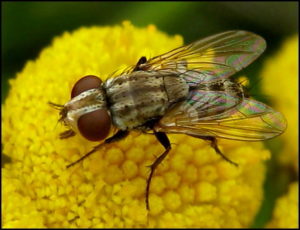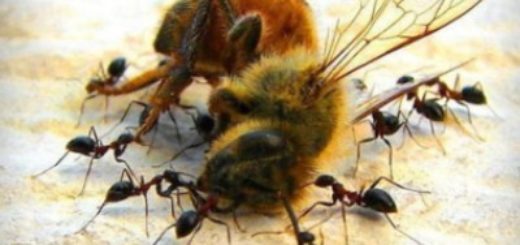Senotainioz – fly pest bees
 Senotainioz – bee disease, methods of dealing with fly.
Senotainioz – bee disease, methods of dealing with fly.
In this article we consider the features of one of the invasions, which can lead to serious problems, including the tangible economic loss, if time does not confuse itself to combat it.
Will talk about senotainioz – disease, which affects flight representatives bee colonies.
Culprit fly infestation senotainiya, rather its larvae – occupy the chest cavity bees.
Characteristics of the pathogen
This fly is not common everywhere. It can be found in apiaries south, beekeeping sites in the middle zone of the country.
Features fly senotainiyi:
- gray (to some extent silver) body color. The latter is similar to that of flies home;
- high fertility. females, we considered species of flies, produce larvae, that is, they belong to the insect viviparous. For the record: house flies lay eggs;
- in females can be from one to seven hundred.
Features larvae:
- length of larvae, which is in the womb (before going to light), 0,8 mm and its width 0,17 mm;
- are temporarily on bees. The next stage of development is in the ground, where they are in the form pupae (false cocoon) for 16-33 days (determined by external conditions).
Following summer female can reproduce a couple of generations.
One of them presented false cocoons, wintering in the soil.
Out of the cocoon of adults accounted for early June.
At the time, it was found, that drought negatively correlated with the number of flies, positive and high humidity.
Therefore, the right decision will be the project apiaries away from water.
Consider: American foulbrood in bees: treatment.
The course senotainiozu
The larvae feed used as tissue bees, including his pecs.
The result of this "diet" – inability infected bees fly. Eventually they will one – death.
The spread of illness
Unlike many other invasions, we considered disease, leave out transfer, they affected insects.
Specifics (sequence) infection. Initially, the bee larvae deposited.
This is followed by the penetration of larvae into the chest cavity individuals. "Door" larvae are webbed segment of Bee.
A few words about symptoms
If a bee is a small number of larvae, the, probably, disease will occur in a latent form.
On the serious extent of lesions indicate many bees creep:.
There have been deaths of half of flying insects, which affects the results medosbora.
Diagnostics
It involves identifying the apiary flies senotainiy.
Confirmation of diagnosis will be that creep on the territory of the bees straightened wings (as if preparing to fly, but for some reason can not).
Absence of these signs can not be a hundred percent guarantee absence of the apiary infestations.
Therefore experienced beekeepers to identify disease using white plates deep water, installed on the hive.
In principle, Plates can be placed on a stool. What is the trick of this method?
Senotainiyi flies amusing light objects, so some of them in any case be in the water traps.
Read: The European foulbrood disease of bees: treatment.
Fighting disease
Far west – porazhonnyh daily burning and dead insects.
Mandatory event – Destruction of adult flies using DDT Douste.
This poison is effective. It is used in several ways.
Method I
Ingredients for making tools: 10% -Nij DDT; starch paste. To prepare the first starch (10 g) dissolved in water (1 l).
The paste cools and is complemented by Dostum (10 g). Means is put on tight and bright wrapping paper (plywood).
For such an operation can be applied brush. Alternative tools – brush.
Fixing pieces, impregnated tool, rooftop hives.
Method II
Ingredients: 10% -Nij DDT (10 g); worked avtol (100 g). They thoroughly mixed.
Efforts same piece, as in the first case and mounted in the same places.



